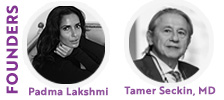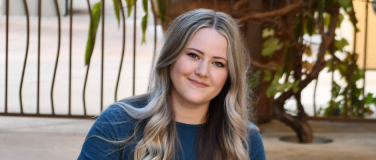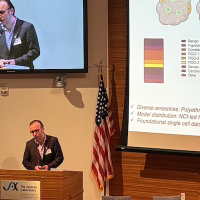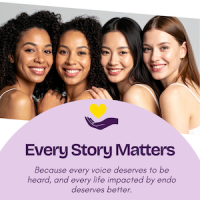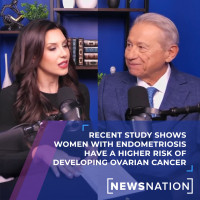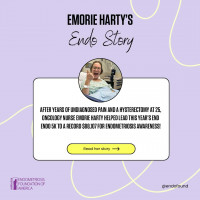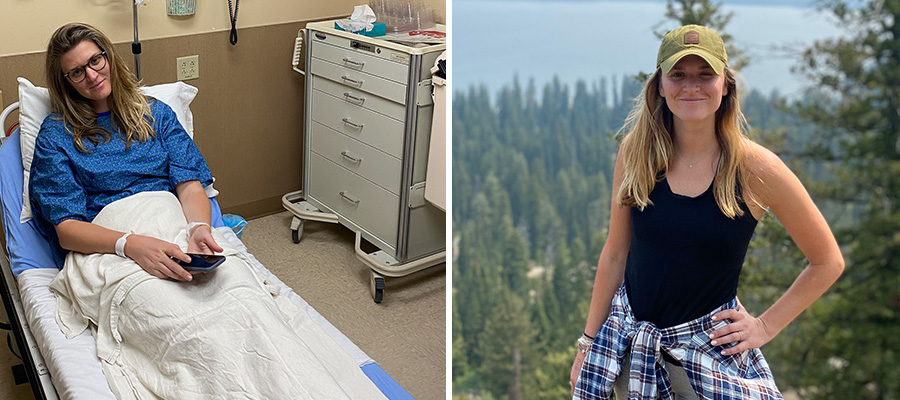
I was in college when I was first misdiagnosed.
Ever since I’d gotten my period at 12, I’d experienced crippling abdominal pain, nausea, heavy bleeding, and fatigue. Doctors had long dismissed my symptoms as normal menstrual side effects, recommending ibuprofen and a heating pad as the antidote. When the pain was unbearable, I’d often make a middle-of-the-night emergency room visit for a hit of morphine, the only remedy to offer any reprieve.
But then, at 20, I had my first massive cyst—eight centimeters in diameter—growing on my ovary. And it wasn’t going away. It was the first piece of evidence that something was truly wrong. It was also the first time a doctor paid earnest attention to my reproductive health. In many ways, I was almost grateful for it—the bodily proof I needed to reassure myself that I wasn’t crazy. The pain was real.
“You have unusually high levels of something called CA 125,” the doctor said. He was a gynecologic oncologist, referred by my regular OB-GYN. “It’s a marker in your blood for ovarian cancer. With a cyst that large, it could be ovarian cancer. We’re going to get you into surgery right away.”
The next morning, I was wheeled into a cold operating room with blinding lights and sterile cement walls. It was then the fear swallowed me. The room shrank. The faces were unrecognizable. Voices of doctors and nurses chattered like schoolchildren, busy but incomprehensible. As the anesthesiologist put me to sleep, I cried. Someone held my hand. I had the laparotomy. They removed the large cyst.
Then, pathology results came back: negative.
It wasn’t ovarian cancer.
“I think it’s endometriosis,” the doctor said in my recovery room, straightening his polka-dot bow tie. “What you had was a chocolate cyst. An endometrioma. One of the biggest I’ve seen. You may not be able to have kids, but otherwise, you’ll be fine.”
He didn’t seem to know much more about the disease—and I was so relieved not to have cancer. I asked what I could do about it. His reply? “Nothing much. You’ll have to live with it.” Like that was that.
Over the next decade, my life took me to five different cities across the U.S. I worked as a high school English teacher in Chicago. Then, I got a job at a big tech company in San Francisco. I got married. We moved to Boulder, Colorado, while my husband went to law school. We bought a house in Denver. I got another job at a smaller startup, and along the way, I switched doctors and OB-GYNs. Frequently.
Sitting naked in a paper gown with bare feet in plastic stirrups and my underwear tucked in between folded jeans, I explained to each new doctor: “I have endometriosis. My period pain is really bad. Sometimes, I can’t function.”
In every office, I was met with different versions of the same sort of medical gaslighting from doctors and nurses alike.
“Are you sure?”
“Did you diagnose it yourself?”
“It’s hard to diagnose endometriosis. You know, you need to have surgery to find it.”
That’s when I would lift my paper gown and show them my scars. “Yes, I’m sure.”
Now, in my 30s, I’ve come to realize that living with a diagnosis of endometriosis means I’d be living with a medical case to defend, often to nurses and doctors who were also women. It is a disease, I’d come to find out, that few in the medical profession believe you have—and even fewer are well-versed in how to treat it.
Endometriosis is a chronic inflammatory disease in which uterine tissue grows outside the uterine cavity. This tissue growth causes abnormal cyst growth, severe pain, infertility, fatigue, depression, and anxiety. According to the World Health Organization, it impacts about 10 percent of people of reproductive age globally. Diagnosing endometriosis is extremely difficult because it can’t be seen on ultrasound, which is why diagnosis is often delayed, dismissed, or misdiagnosed altogether. It’s estimated that 50 percent of women who have experienced or live with infertility have endometriosis. Likewise, women with endometriosis have an increased risk of miscarriage.
There is no cure. Treatment is largely targeted at symptom management, and options are extremely limited. Think over-the-counter pain medications, birth control, medically-induced menopause, hormonal therapy, and surgery. Each surgery can help alleviate symptoms, but it’s temporary, as the disease will grow back. Endometriosis is reported to be one of the top 20 most painful medical conditions by the NHS and has been cited to be worse than heart attacks and childbirth pains. In a bad endo flare-up, my pain is so excruciating that I spend hours curled in the fetal position in the shower, not caring when the water runs cold. I vomit and bleed through ultra-sized tampons and pads in an hour. I’m unable to walk, make or eat meals, think clearly, and, least of all, work. Sadly, women with endometriosis are at four times the risk of chronic opioid use than women without.
Over the years, I’d tried everything to help my stage four endometriosis: birth control, medically-induced menopause and hormonal therapy, a prescription for Naproxen, heating pads at work in my desk drawer, heating pads at home, heating pads stowed underneath my side of the bed. I’ve had more surgery to remove the disease: recurrent, fast-growing ovarian cysts, lesions and scar tissue, and even collapsed reproductive organs. I am still a frequent visitor to the ER when my pain is too debilitating, but this time, with my husband in tow, holding my buckled-over body in the waiting room while I pray to get an IV of morphine.
It all explained why we were failing to get pregnant. Our only option to have a family was IVF.
Sitting in my IVF clinic, I told my doctor my diagnosis in our introductory consult: I have stage four endometriosis. She was the first physician who said the words I’d been craving to hear for more than a decade.
“I’m so sorry to hear that.”
She was the first doctor who didn’t question it. Who didn’t quiz me on what I knew about the disease. Who didn’t ask if I self-diagnosed because of bad period cramps and so-called signs of infertility. Who didn’t make me lift my shirt and unbuckle my jeans to see the scars that made my endometriosis real.
There’s something inherently vulnerable when your body doesn’t work the way it’s supposed to. But the grief of knowing your body will fail at its most basic reproductive function—of creating another life when it’s seemingly so easy for everyone else—is indescribable. It’s a pain I don’t wish on anyone, one riddled with stigma and shame.
Then, to know exactly why your body is failing, only to be questioned whether your diagnosis is real. At the same time, you’re also receiving an influx of advice and comments—albeit most were well-meaning—from friends and family with instructions on what to do about it.
You’re probably stressing about it too much. It’s about your mindset.
I got pregnant naturally, it could happen to you!
Have you tried this supplement?
Just stay positive!
You could always just get a surrogate.
You think this is hard? Just wait until you become a parent.
You should bring children into this world God’s way.
It’s a mind fuck.
It’s no secret that women’s health is chronically underfunded. But even in comparison to other women’s health conditions, endometriosis—also known as the “missed disease”—is woefully left behind. The NIH allocates nearly $48 billion annually to the study of various diseases and conditions. In 2022, the total U.S. funding for endometriosis was $16 million, which translates to just $2 per patient per year. In stark contrast, according to the National Institutes of Health, diseases affecting men receive twice as much funding in the U.S. as those affecting women.
In January 2025, the World Economic Forum, in collaboration with the McKinsey Health Institute, published a distinctive report that underscores the economic and societal potential of closing the women’s health gap. The report focuses on nine key women’s health conditions—including endometriosis—that drive a third of the women’s health gap and outlines actionable solutions to address disparities in treatment.
The headline? Closing the gap could add almost 27 million disability-adjusted life years annually and $400 billion to the global economy by 2040—not to mention improve the quality of life for women worldwide. According to the report, effective treatments and earlier diagnosis for endometriosis alone could contribute an estimated $12 billion to the global economy. Due to the difficulty of diagnosis and undercounting of endometriosis cases, this number is likely a conservative estimate, at best. While it’s frustrating, to say the least, that the well-being of women’s health and lives is valued through monetary contributions to the global economy, perhaps lost capital is what will make people pay attention to the disease.
In May 2024, a bipartisan Endometriosis CARE Act was introduced to Congress by Georgia Congresswoman Nikema Williams, which would deliver $50 million annually to advance endometriosis research and expand access to treatment. The bill would also establish a national campaign to promote public awareness of endometriosis and identify barriers to accessing treatments, such as healthcare coverage, transportation, and healthcare professional shortages.
It’s been almost 15 years since my diagnosis. Against all odds, we have a beautiful baby boy who turned one in April. For women and girls everywhere still searching for answers, they’re coming. We just have to keep advocating for them
*Patient stories submitted to EndoFound.org are the patient's views, not necessarily those of the foundation. All testimonials are from real patients, may not reflect the typical patient’s experience, and are not intended to represent or guarantee that anyone will achieve the same or similar results.

